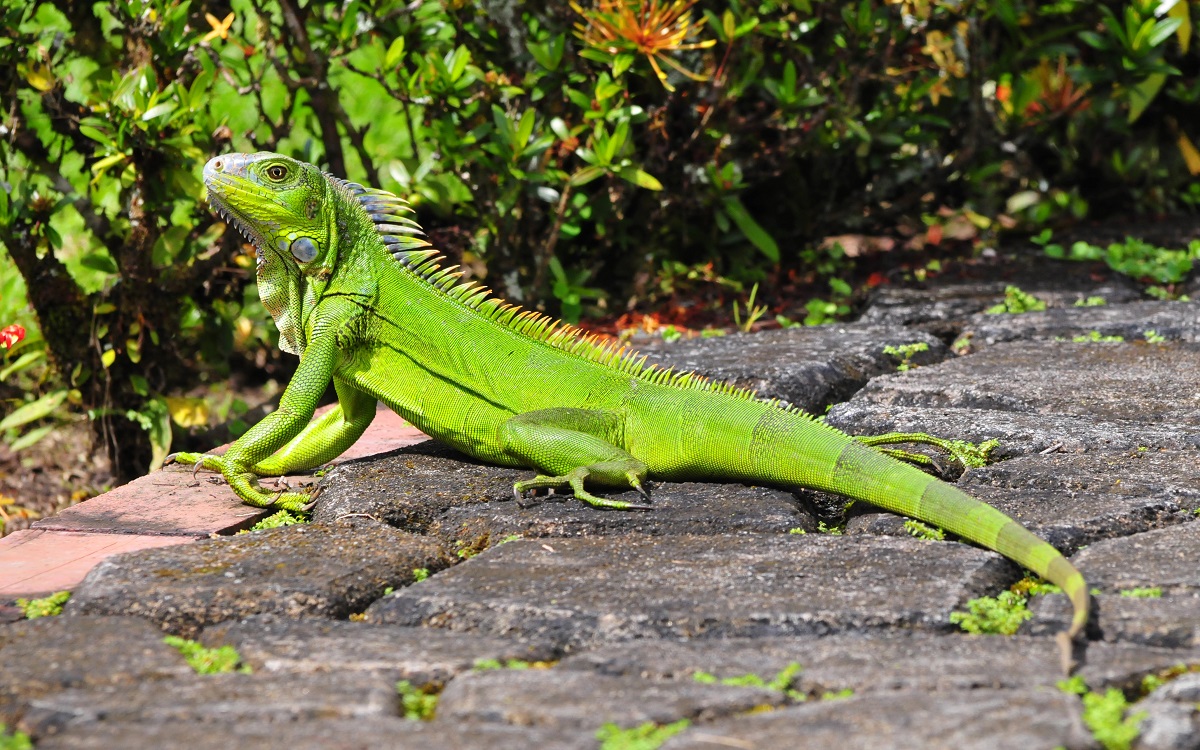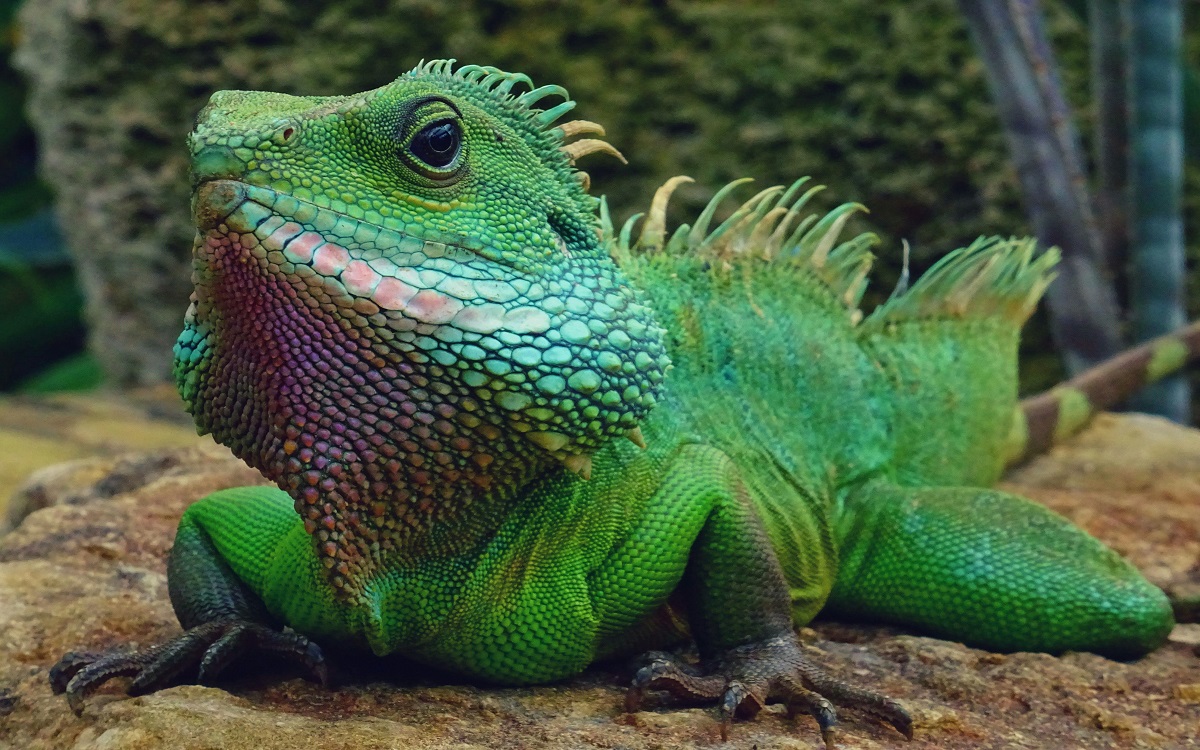One of the first questions many people ask is: are iguanas good pets? The answer depends on your experience level, expectations, and ability to commit to their care needs.
Green iguanas are among the most popular reptiles kept as pets, thanks to their striking appearance and fascinating behaviors. However, they are not beginner reptiles—caring for one requires serious commitment, space, and proper equipment. If you’re considering adding one to your home, here’s a comprehensive guide covering everything from temperament to housing, diet, and health.

Behavior and Temperament
Green iguanas (Iguana iguana) are generally solitary, arboreal reptiles that spend much of their time basking and climbing. While they can become accustomed to human interaction, they are not naturally cuddly or affectionate like cats or dogs.
- Temperament:
- Juveniles may be skittish and whip their tails when threatened.
- With consistent, gentle handling, some can tolerate human interaction and become relatively calm.
- Adult males can become territorial and even aggressive, especially during breeding season.
- Intelligence: Iguanas are smarter than many reptiles. They learn routines, recognize their owners, and may even respond to regular feeding times.
- Handling caution: They have sharp claws, strong tails, and can deliver a painful bite if stressed. Respecting their boundaries is essential.
So, while iguanas can be rewarding for dedicated reptile keepers, they are not the best choice for beginners or anyone looking for an easygoing, low-maintenance pet.
Caring For Iguanas
When it comes to caring for iguanas, consistency and commitment are key. These reptiles need large enclosures with proper heat, UVB lighting, and humidity to mimic their tropical habitats. Their diet must be strictly herbivorous, focusing on fresh greens and vegetables, and they require regular handling to remain tame. With the right setup, daily attention, and understanding how to care for an iguana, they can thrive and become fascinating long-term companions.

Housing Requirements
Green iguanas grow much larger than most people expect—often up to 5–7 feet long, with most of that being tail. Because of their size and arboreal habits, they need enclosures that mimic their natural environment as closely as possible.
- Size: An adult iguana requires a minimum enclosure size of 8 feet long, 6 feet tall, and 4 feet deep. Ideally, you should aim for a custom-built habitat the size of a small room or walk-in closet. Hatchlings can start in smaller enclosures, but they will quickly outgrow them.
- Shape: Height is as important as length. Iguanas love to climb, so vertical space with shelves and branches is a must.
- Construction materials:
- PVC or sealed wood enclosures retain heat and humidity better than glass tanks.
- Glass tanks are fine for young iguanas but usually too small for adults.
- Substrate (flooring): Newspaper, reptile carpet, or sealed tile works best. Avoid loose substrates like sand, bark, or mulch, as these can cause impaction if ingested.
- Ventilation: Enclosures should have cross-ventilation, but not so much that humidity drops.
- Climbing structures: Thick branches, ramps, hammocks, and platforms are essential for enrichment and exercise.
- Basking areas: Elevated basking shelves allow them to soak up heat and UVB light.
Some owners even dedicate an entire room of their home as an “iguana room,” fitted with heating, lighting, and climbing furniture. This is often the best long-term solution given their size and activity needs.
Lighting and Heat Needs
Iguanas are tropical reptiles that rely on external heat and UVB light to regulate their metabolism and stay healthy. Without the right lighting setup, they can quickly develop metabolic bone disease or other serious illnesses.
Practical Setup Tips:
- Heat sources:
- Use a ceramic heat emitter or large reptile basking bulb for the basking area.
- Avoid heat rocks—they can burn your iguana.
- Keep multiple digital thermometers in the enclosure to monitor basking and cool zones.
- Temperature gradient:
- Basking spot: 95–100°F (35–37°C)
- Mid-level ambient temp: 80–85°F (26–29°C)
- Lower/cooler areas: around 75°F (24°C)
- UVB lighting:
- Choose a high-output linear UVB bulb (such as a T5 HO 10.0 or 12%). Compact bulbs don’t cover enough space for a large enclosure.
- Position the UVB bulb across at least half the length of the enclosure, 12–18 inches from the basking shelf.
- Replace UVB bulbs every 6–12 months (even if they still give off visible light).
- Lighting schedule:
- Keep lights on for 12–14 hours daily, mimicking a tropical day.
- Put them on a timer for consistency.
Humidity Needs
Because iguanas are native to humid tropical forests, maintaining the right humidity is just as important as heat and UVB.
Practical Setup Tips:
- Humidity level: Keep it between 70–80% at all times.
- Monitoring: Use a digital hygrometer at multiple points in the enclosure.
- Ways to maintain humidity:
- Mist the enclosure at least 1–2 times daily with warm water.
- Add a large water dish big enough for the iguana to soak in. This also helps with hydration.
- Use live plants like pothos or philodendron, which naturally boost humidity.
- Consider an automatic misting system (like MistKing) or an ultrasonic fogger to maintain consistent humidity.
- Ventilation balance: Too much ventilation will drop humidity, but too little will cause mold. Aim for airflow that keeps the air fresh without drying the enclosure.

Diet, Feeding, and Water
Green iguanas are strict herbivores. Feeding them the wrong diet (such as animal protein) can lead to serious health issues, so their meals should always be plant-based.
- Staple greens: Collard greens, mustard greens, dandelion greens, turnip greens, and escarole.
- Other veggies: Squash, bell peppers, green beans, carrots (in moderation).
- Occasional fruit: Mango, papaya, strawberries, blueberries, banana (sparingly).
- Avoid: Lettuce (nutrient-poor), spinach (binds calcium), animal protein (eggs, meat, insects).
- Supplements: Use calcium powder (without phosphorus) 3–4 times per week and a reptile multivitamin once a week.
Water and Hydration
Hydration is just as important as food for iguanas:
- Provide a large, shallow water dish in the enclosure at all times. Many iguanas will soak in it, which also helps with humidity.
- Change the water daily to keep it clean, as iguanas often defecate in their water dish.
- Mist their food lightly with water before feeding to boost hydration.
- Some iguanas may drink directly from droplets on leaves or surfaces, so daily misting also encourages natural drinking behavior.
- Never rely only on their food for hydration—always offer fresh water.
Health and Behavior Problems
Without proper care, iguanas are prone to serious health problems.
- Metabolic Bone Disease (MBD): Caused by lack of UVB or calcium. Leads to deformities and weakness.
- Respiratory infections: From low temps or humidity. Signs include wheezing, mucus, lethargy.
- Parasites: Internal and external parasites can affect wild-caught or stressed iguanas.
- Aggression: Males may become aggressive in breeding season, especially if housed with other iguanas.
Regular vet checkups with a reptile specialist are important.
How to Choose the Right Iguana
If you’ve decided a green iguana is right for you, be selective when choosing one.
- Captive-bred is best: Wild-caught iguanas are often stressed, dehydrated, and carry parasites.
- Look for signs of health:
- Bright, alert eyes
- Smooth, intact skin
- No visible wounds or swelling
- Strong appetite
- Temperament: Young iguanas may be jumpy, but avoid individuals that are extremely weak or lethargic.

Other Important Considerations
- Longevity: Green iguanas can live 15–20 years with proper care.
- Space and commitment: They require more care than many cats or dogs.
- Legal issues: Check your local laws, as some places restrict or ban ownership.
- Costs: Enclosures, UVB bulbs, heating equipment, and food add up—expect significant long-term expenses.
Cost Breakdown: What It Really Takes to Own a Green Iguana
Caring for a green iguana isn’t just about time—it’s also a financial investment. Here’s a general estimate of what you can expect:
| Expense | Estimated Cost (Startup) | Ongoing Cost (Yearly) |
|---|---|---|
| Custom Enclosure (8x6x4 or larger) | $500–$1,500 | — |
| Heating & Lighting Setup (UVB, basking bulbs, fixtures) | $150–$300 | $100–$200 (bulb replacements) |
| Humidity Control (misters, fogger, hygrometers) | $50–$150 | $50–$100 |
| Climbing Furniture, Shelves, & Décor | $100–$300 | $50–$100 |
| Food (fresh greens, veggies, supplements) | — | $400–$600 |
| Veterinary Care (checkups, emergencies) | — | $100–$500+ |
| Estimated Total | $800–$2,250 | $700–$1,500+ |
Final Thoughts
Green iguanas are stunning, fascinating reptiles, but they’re high-maintenance pets that aren’t ideal for beginners. If you can commit to providing the space, heat, UVB light, humidity, proper diet, and long-term care they need, they can become rewarding companions and impressive members of your household.
